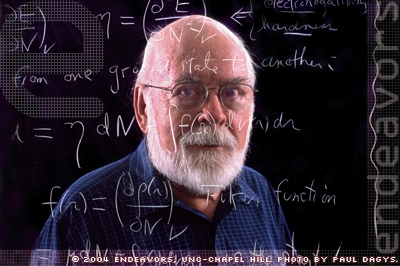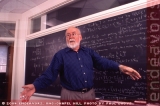It’s hard to keep Bob Parr out of his laboratory. He is a professor of chemistry, but his lab contains no chemicals. It is not cluttered with roundbottom flasks or electronic gadgetry; it has no Bunsen burners or test tubes. When I ask him a question, though, he pops out of his chair and leads me to his lab. He strides six feet to a blackboard and begins scribbling equations at an astounding rate. Parr, you see, is a theoretical chemist, and the blackboard is his lab. He admits that the last experiment he performed was as a graduate student at the University of Minnesota over fifty years ago.
The equations that intrigue Parr contain symbols unknown to most of us. Multiple integrals, Hamiltonian operators, and vector field notations can confound even the mathematically inclined, and they are sheer gibberish to those who aren’t. This leads to a question: why should one care about obscure squiggles on a blackboard? Well, those squiggles appeared in a remarkable scientific paper that other scientists have used in research that can dramatically affect our lives, research that ranges from developing anthrax vaccines to determining how much radiation therapy the human body can stand without damaging its DNA.
Parr’s own research concerns the wave equation, the fundamental equation of quantum mechanics. It was formulated by the Viennese physicist Erwin Schrödinger in 1925 during a romantic tryst with a girlfriend at a Swiss ski resort. The wave equation is a mathematical statement of how electrons behave in atoms. In the old solar-system model of the atom, electrons are the negatively charged planets that revolve around a positively charged nucleus. In Schrödinger’s equation, electrons are described as waves. The equation was confirmed, Parr says, back in the 1920s when it accurately predicted the properties of the hydrogen atom. But a hydrogen atom consists of only one proton in the nucleus and one electron. Scientists later used the wave equation to determine the properties of the hydrogen molecule, which consists of two hydrogen atoms. But when they tried to apply wave theory to more complex atoms and molecules, the mathematics became so intractable that solving the equation was regarded as impossible. “I sometimes describe my career as trying to solve that single equation,” Parr says, returning to a chair in his airy office in the chemistry department.
With his short, neatly trimmed white beard, Parr looks a bit like Ernest Hemingway. Unlike Hemingway, who often posed in bars, Parr is usually photographed in front of a blackboard filled with equations. But when he talks, he often speaks not of mathematics but of people. Walter Kohn, a 1998 Nobel Prize winner, is “a lifelong friend.” John Pople, another Nobel winner, whom Parr met at Cambridge University, is also a long-time friend. And so was the well-known DuPont chemist Rudolph Pariser. Parr clearly relishes the friends he has accumulated during a lifetime in chemistry. But he also loves chemistry, and he played a key role in one of the most important advances in theoretical chemistry in the twentieth century, a development known as density functional theory (DFT).
The first breakthrough came in the early 1960s when Walter Kohn and Pierre Hohenberg showed that electron density theory is mathematically equivalent, in principle, to Schrödinger’s wave theory. This meant, that if one knew the electron density (that is the how the electrons are arranged in space) of an atom or molecule, one could calculate its properties. The simplification allowed chemists to determine the properties of large molecules without having to work through the complexities of the wave equation. DFT math isn’t a walk in the park, but it is easier than solving the wave equation.
Consider water. It is a simple molecule composed of two hydrogen atoms and an oxygen atom. Using DFT, chemists can determine how strongly the hydrogen atoms are bound to the oxygen and the angle between the hydrogen atoms. Knowing this, they could determine many of the properties of water. Of course, the properties of water are already known from experiment, but DFT can be applied to molecules whose properties are not known.
A decade before DFT was shown to be equivalent to wave theory, Parr had already made significant contributions to chemistry. Working with Rudolph Pariser, he had developed a mathematical method to predict the color of dyes. This was not trivial to the DuPont Company because dyes were big business in those days. Figuring out what chemical would give a certain shade of, say, green was cheaper than making it and seeing what color it produced. The Pariser-Parr method (later known as the Pariser-Parr-Pople method) established Parr as one of theoretical chemistry’s stars.
Meanwhile, DFT was gaining converts in chemistry, but a huge problem plagued the theory. One approximation involving the correlation energy had, as Parr says, “a lot of error in it.” (Correlation energy is a mathematical expression that accounts for how the electrons in a many-electron system interact with one another.) In 1988, Parr, working with his postdoc Weitao Yang and graduate student Chengteh Lee, published an improved method of approximating the correlation energy. To most of us, the paper — known as LYP after the authors Lee, Yang, and Parr — appears to be a jumble of arcane mathematics. But for practitioners of DFT, it was a major advance, making far more accurate calculations possible.
When the paper was published, Parr was sixty-eight years old. The esteemed science fiction writer Arthur C. Clarke once wrote — perhaps when he was a young man — that “scientists over fifty are good for nothing except board meetings…” Sometimes, even esteemed science fiction writers can be wrong.
Parr has authored or coauthored more than two hundred scientific papers and mentored over 120 graduate and postgraduate students, but he regards LYP as his group’s most significant contribution. Other chemists apparently share that feeling. Chemical Abstracts Service compiles a list of the number of times papers are cited by other scientists in their publications. LYP was the second most cited paper in the chemical literature for four years in a row, from 1999 to 2002. By mid-2004, LYP had been referenced in 10,696 papers.
Scientists have broadly applied LYP’s mathematical squiggles. In 2004 alone, they cited LYP in papers ranging from nanotechnology developments to the synthesis of antibiotics. One paper explores “Radiation damage of biosystems.” Another is ominously titled “Identification of small molecule inhibitors of anthrax lethal factor.”
Parr and his coauthors have been amply rewarded for their work. Chengteh Lee received his Ph.D. from Carolina in 1987 for his work on DFT and is now a senior scientist at the supercomputer company Cray, Inc. Parr was named to an endowed chair in 1990, becoming the Wassily Hoeffding professor of chemical physics, and he has enough awards to fill a page.
But two stand out. Parr has been elected to the National Academy of Sciences, the country’s most prestigious scientific organization, and this year, he received its Award in Chemical Sciences “for being a pioneer, leader and central figure in the development of density functional theory in chemistry.” The award included a medal and fifteen thousand dollars in cash.
One prize that has so far eluded Parr is the biggest of them all: the Nobel. But he has come as close to it as a nonwinner can. When the Nobel Committee selected Walter Kohn and John Pople for the prize in chemistry in 1998, Kohn invited Parr and Hohenberg to the ceremony. “For about two-thirds of my life,” Kohn later wrote, “Bob Parr has been a wonderful friend and colleague.” In a photograph in Parr’s office taken at the Nobel ceremonies in Stockholm, the three amigos, in white tie and tails, gaze into the camera.
Weitao Yang, the Y of the LYP trio, has done all right for himself too, although he had to move a few miles down the road to reap his reward. He holds the prestigious Philip Handler professorship in chemistry at Duke University. His office is in the huge, secluded chemistry building on Duke’s west campus. The walls are lined with books and the floor is carpeted with technical papers.
Yang was born in China and got his undergraduate degree at the University of Peking. After getting his Ph.D. under Parr at Carolina, he worked as a postdoc at Berkeley before accepting a job at Duke. “I am almost a native North Carolinian,” he says. “I have been here longer than anywhere else in the world.”
Yang has his own research group today, consisting of nine graduate students and postdocs. He has continued his work with DFT, applying the theory to, among other things, catalysts, especially enzymes. Catalysts are substances, he explains, that speed up chemical reactions, and enzymes are the catalysts present in living organisms. “Virtually all the reactions in our bodies are catalyzed by enzymes,” he says. We know enzymes work, he continues, but “we don’t know how they work. We hope to learn how to design enzymes to do the things we want. You can use them to clean the environment, make chemicals for engineering processes.”
Finally, some real experiments, I think. I visualize his lab buzzing with activity as chemists in white coats study the properties of enzymes, heating and cooling, measuring reaction rates with fancy equipment.
“How many people in your group are doing experimental work?” I ask. “None,” he says. “All theory, all computers.”
Parr usually speaks slowly and carefully. But when he gets going on a topic, he cannot stay seated. He jumps up and expresses himself mathematically, scratching out equation after equation on his blackboard. Being aware of this tendency, I ask him to remain seated during our last interview so I can record his answers in English and avoid trying to follow his math. We review a few of the papers citing his work, how LYP has proven useful to researchers in many fields. How the practical applications of its mathematics help ordinary people when other scientists use it to develop new antibiotics, better catalysts, and promising vaccines. Ever modest, Parr points out that the many citations of LYP “is a characteristic of quantum chemistry as it’s applied.” That is, one would expect theoretical advances would be cited often because most papers in the chemical literature deal with applications.
Parr, however, is not fascinated by the applications of quantum chemistry; he loves the theory itself. So it’s no surprise when our discussion turns again to the Schrödinger wave equation. He points out that scientists now use supercomputers to solve the wave equation for systems larger than the hydrogen molecule. But even with these computers, he says, “DFT works better for systems of one hundred or more electrons.”
I save what I hope is an easy question for last. “DFT stands for density functional theory. I know what a function is, but what is a functional?”
“A functional is a function of which the variable is a function,” he begins slowly.
“A function is a rule for going from a number x to another number f(x),” he says, speaking faster, warming to the subject. “And a functional is a rule for going from a function f(x) to a number F(f).”
He notices the blank look on my face.
“It’s simple,” he says, ignoring my earlier request, moving to the blackboard, furiously writing complex equations. Bob Parr is back in his lab, doing what he loves.
Phillip Manning was a freelance contributor to Endeavors.
Phillip Manning has a Ph.D. in chemistry from Carolina, which he earned “a long time ago.” These days he writes about science; read his reviews and essays at http://www.scibooks.org.




